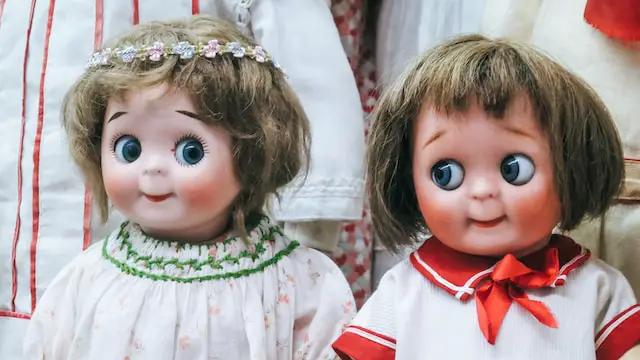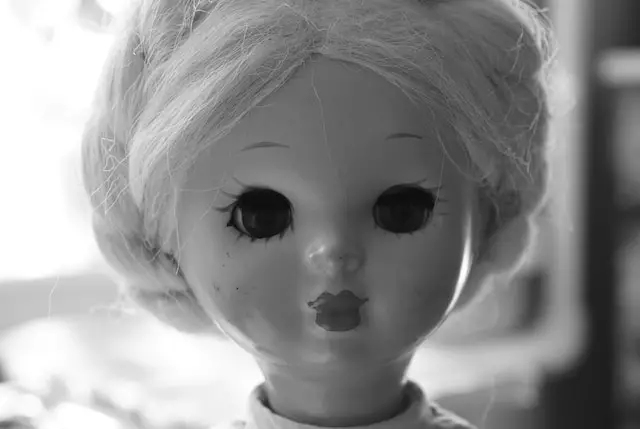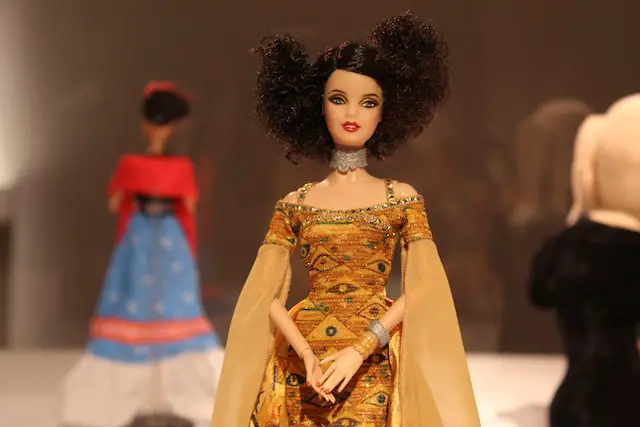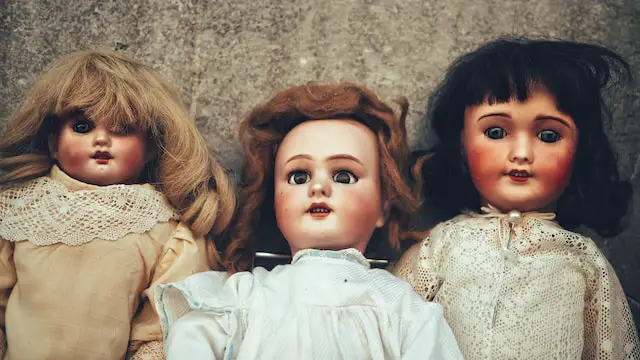How To Dye Doll Hair?
Hot water should be poured into a big bowl or container. The water ought to be hot enough to cause the color to dissolve.
To protect your hands from the dye, put on some rubber gloves.
Mix the hot water with the cloth dye as directed on the packaging. Once the dye has completely dissolved, stir the water with a spoon.
Dip the doll’s hair into the dye mixture with caution. Ensure that the dye has completely covered all of the hair.
Let the hair soak in the dye for at least 30 minutes if you want a darker color. To ensure that the hair is evenly dyed, you can also swirl the color into the hair.
Making The Doll
Dolls are a wonderful accessory to your collection, regardless of whether you’re a dolls fan or a photographer searching for an unusual subject. But, before you begin showing or taking photos of your doll, there are some things to consider to prepare it correctly. Here are some suggestions and tricks to prepare the doll:
Cleaning The Doll
The first step to preparing a doll is cleaning it thoroughly. Based on the quality of the doll, it can require different methods. These are general suggestions for cleaning the doll:
- Dust the doll with a dry, soft cloth. This will eliminate any dust on the surface and prevent it from getting stuck in crevices.
- Use a soft-bristled, soft-bristled brush to gently scrub the delicate parts of your body, like the hair or face.
- Use a moist sponge or cloth with mild soap and water if the doll is stained or marked. Use it to gently cleanse the areas affected. Make sure to try the soap on an unnoticeable area first to ensure that it won’t cause damage to the doll.
- You can use mild abrasive cleaners such as toothpaste or baking soda, applied with a soft, clean cloth, for stains that are difficult to remove or stubborn. Test the cleaner in a small portion first to ensure that it doesn’t cause damage to the doll.
Preparing The Doll’s Hair
The hair of the doll is often one of the most important aspects, especially for photography. Here are some suggestions for styling the hair of a doll:
- Brush or comb your doll’s hair gently to eliminate knots or tangles. Make use of a comb or brush suitable for the doll’s hair type. For instance, you could use a comb with wide teeth for hair with curly curls.
- You can clean your hair with mild shampoo and conditioner if it is especially messy. Rinse the hair with plenty of water and avoid using a hot dryer or wash since this can harm synthetic hair.
- Hairstyles for dolls are according to your preference. You can use clips, hair elastics, or pins to make a variety of hairstyles. Be careful not to use something too tight, as it could cause damage to the doll’s hair.
- If your doll’s hair is tangled or frizzy, you can apply a detangling spray or serum to smooth it out. Make sure you apply a product appropriate for your hair made of synthetic fiber.
Repairing The Doll
If your doll has wear and tear or damage, it is important to fix it before displaying or photographing it. Here are some helpful tips to repair your doll:
- If your doll is missing or has loose parts, like legs, arms, or legs, you may use sturdy glue like super glue or epoxy to fix them. Ensure you adhere to the directions carefully and let the adhesive completely dry before taking the doll out of its container.
- If the doll’s clothes are damaged or torn, If the doll’s clothing is damaged or torn, you can use thread and a needle to stitch it back. Make sure to use thread that is in line with the color of the garment, and stitch the stitches as discreetly as you can.
- If the doll’s face has been damaged or scratched , you can apply a fine-tipped brush and acrylic paint to cover the areas affected. Make sure you match the color of the paint as closely as you can and apply it in small, thin layers.
- If your doll has corrosion or rust around its metallic parts, for instance, joints, you can use a rust remover to clean the parts. Ensure you follow the directions carefully and avoid getting any of the removers to the doll’s skin or clothes.
Gathering The Tools Needed
Before you begin any project, gathering all the required tools is essential. Being equipped with the right tools on your desk can simplify the task and ensure that the final product is of high quality. Here are some helpful tips for gathering the required tools for various projects:
DIY home improvement
If you plan to make home improvements, like painting your home or installing new fixtures, you’ll require several tools. Here are some of the tools you can think about:
- Tape measure: A tape measure is crucial to measuring spaces and ensuring everything fits correctly.
- Level: A level is helpful to ensure that surfaces like picture frames or shelves are straight.
- Set of screwdrivers: A set of screwdrivers, including Phillips-head and flathead screwdrivers, can be useful for various tasks.
- Hammer: Hammers are useful for tasks like hanging pictures or nailing nails.
- Rollers and paint brushes: If you plan to paint, you’ll require various rollers and brushes for different surfaces.
Gardening
If you’re planning to do some gardening, regardless of whether it’s a tiny backyard garden or a massive vegetable garden, you’ll require the basics of tools. Here are some tools you can consider:
- Trowel: A trowel is necessary for transplanting and planting small plants.
- Pruners: Pruners help trim branches and cut back overgrown plants.
- Garden hose: A garden hose is essential for watering plants.
- Gloves: Gardening gloves protect your hands from thorns, sharp branches, and other dangers.
- Shovel: A shovel is helpful to dig holes and move soil.
Photography
If you’re planning to do some photography for professional or personal use, you’ll require various tools. Here are a few tools to think about:
- Camera: Of course, you’ll need cameras to take pictures. You may need a film or digital camera based on your needs. In addition, you’ll have to select the right lens.
- Tripod: A tripod can aid in keeping your camera steady and prevent blurry images.
- Lighting equipment: Based on your lighting requirements, you may wish to invest in lighting equipment, like softboxes or reflectors.
- Memory cards: If you’re using digital cameras, you’ll need memory cards to save your images.
- Editing software: After you’ve taken your pictures, you’ll likely need to alter them. Many software options exist, from free ones such as GIMP to professional applications such as Photoshop.
Crafts
If you’re planning to do some craft, whether it’s knitting, sewing, or scrapbooking, you’ll require various tools. Here are some tools worth considering:
- Scissors: A quality pair of scissors is essential to numerous crafting projects.
- Sewing machine: If you plan to sew using a machine, it can save you lots of effort and time.
- Thread or yarn: By the task you’re working on, you’ll need thread or yarn in different colors.
- Glue: Quality glue, like hot glue guns or craft glue, can be an essential tool for crafting.
- Cutting mat: If you plan to cut fabric or paper, a mat will safeguard your surface from damage and help you cut more easily.
Whatever project you plan to tackle, it is essential to have all the necessary tools. This makes the process simpler and will ensure the final product is high quality.
Rinsing The Hair
Rinsing dolls’ hair is crucial in maintaining their appearance and health. Properly rinsing can help remove dust, dirt, and other particles from hair and any applied styling products.
Choosing The Right Water Temperature
- Warm water: Warm water is usually the ideal temperature for washing doll hair. This temperature will help open the hair’s cuticles and allow for a thorough cleansing without damaging the hair or making it dry or brittle.
- Cold Water: Cold water can be used to wash hair dolls, particularly in hair styled using heat or chemically treated. Cold water can seal the hair’s cuticles and lessen frizz, making hair appear more smooth and shiny.
Using the Right Shampoo
- Gentle Shampoo: When washing doll hair, it is important to use a gentle shampoo specifically made to be used on dolls’ hair. Avoid rough or aggressive shampoos since they can damage hair, causing it to dry or be fragile.
- Clarifying Shampoo: If a doll’s hair is heavily styled or has lots of product buildup, clarifying shampoos are a good option to get rid of any extra residue. But clarifying shampoos should be used only on a limited basis since they can dry hair.
Rinsing Techniques
- Gentle rinse: When washing doll hair, it is essential to gently touch and refrain from pulling or tugging on the hair. Utilize a gentle flow of water to wash the hair and avoid scratching or rubbing the hair too much.
- Sectioning: To ensure that all hair is thoroughly cleaned, consider separating the hair and washing each section separately. This ensures that all hair is completely cleaned and no areas are missed.
Styling Hair
The art of styling doll hair is essential to creating an individual and distinctive appearance for your doll. If you’re trying to create simple hairstyles or an elaborate style, there are a few key aspects to consider when styling hair for dolls.
Preparing The Doll Hair
- Brushing and detangling: Before starting any hairstyle, it’s essential to detangle and brush the doll’s hair thoroughly. Use a comb or a brush designed specifically for doll hair, and move slowly and carefully to ensure you don’t damage hair. Begin with the end of the hair, and gradually work your way to the roots to stop knots or tangles from developing.
- Conditioning: Conditioning hair for dolls will make it easier to manage and easy to style. Apply a conditioner specifically for doll hair and then apply it to your hair before washing it off with warm water. This can make the hair soft and more flexible. This will help it be easier to style and avoid damage.
Choosing The Right Tools
- Combs and brushes: Selecting the proper combs and brushes will make a huge difference in the outcome of the hairstyle. Make sure to use combs and brushes specifically made for doll hair, and avoid using ones that are too rigid or with sharp edges, which could cause hair damage. A wide-tooth comb can be an ideal tool for separating and detangling hair, and a soft-bristled comb is a great tool to style and smooth hair.
- Hair Accessories: Hair accessories like clips, bows, ribbons, and clips can add interest and style to hairstyles. Pick accessories appropriate to the type and size of hair dolls, and make sure to use them sparingly to avoid overpowering the hairstyle.
Creating The Hairstyle
- Sectioning: The doll’s hair is divided into sections. It will help create an easier and more precise hairstyle. Use hair ties or clips to separate the hair and work on a section at a time to properly style every section.
- Hair Styling with Heat: Tools for styling hair using heat, like curling irons and straighteners, can be employed to create various hairstyles. However, it’s essential to utilize these tools in a controlled manner and not use them too often since they can harm hair over time. Use a low-heat setting and a heat protector spray to limit damage, and watch your hair carefully when using these devices.
Aftercare
- Washing and conditioning: After styling doll hair, it’s crucial to take proper care of it. Use gentle shampoo and conditioner to clean and condition the hair. Avoid using harsh chemicals or hair styling tools that may cause hair damage.
- Brushing and detangling: Make sure to brush and untangle hair frequently to prevent knots and tangles from forming. Use a comb, or brush specifically made for doll hair and use it slowly and carefully to prevent damaging the hair.
Common Problems When Dyeing Doll Hair
Dying hair for dolls can be an enjoyable way to give a doll a fresh appearance. But, a few common issues can occur when doing the procedure.
Choosing The Right Dye
- The type of dye: The most frequent issue when coloring doll hair is selecting the correct kind of dye. Not all dyes work on doll hair. Making use of the wrong kind of dye could cause hair damage. It is essential to choose the right dye that is made for natural or synthetic hair.
- Color Matching: Another issue when coloring doll hair is the issue of color matching. It can be difficult to attain the desired shade while dyeing doll hair, particularly when working with different hair types or shades. It is important to select the color closest to the desired hue as possible and test the dye on a tiny piece of hair before coloring the whole head.
Preparing The Doll Hair
- Cleaning: When dyeing hair for dolls, it is important to thoroughly wash the hair. This will help eliminate any oil, dirt, or other residue that might hinder the dyeing process. Use mild shampoo and warm water for washing your hair, and let it dry completely before beginning the dyeing process.
- Conditioning: Conditioning the hair of dolls will help prepare them for dyeing. Use a conditioner specifically made for doll hair and then apply it to hair before washing it out with warm water. This will help create hair that is more responsive to dyes and prevent hair damage.
Applying The Dye
- Even application: One problem with coloring doll hair is achieving an evenly applied application of dye. It is important to evenly apply the dye across all hair sections to ensure the hue is uniform. Use a comb or brush to ensure the dye is distributed evenly and avoid any spots or clumping.
- Time and temperature: Another issue when dyeing hair dolls is the timing and temperature. The length of time the dye remains on the hair and the temperature of the water, may influence the final result. It is essential to follow the directions on the dye package and observe the hair’s condition during the dyeing process.
Aftercare
- Conditioning and washing: Following the dyeing of doll hair, it is important to continue caring for it properly. Use mild conditioner and shampoo to clean and condition the hair. Avoid applying harsh chemicals or styling tools that could damage hair.
- Color fades: With time, the color of dyed hair could start to fade. To avoid this, avoid exposing yourself to UV rays or direct light sources, which can cause the shade to fade faster. It could also be necessary to retouch the color regularly to maintain the desired color.
FAQ’s
What type of dye should I use for doll hair?
You should use fabric dye or acid dye, which can be found at craft stores or online. Avoid using regular hair dye as it is too harsh for doll hair.
How do I prepare the doll’s hair for dyeing?
First, brush the doll’s hair to remove any tangles. Then, soak the hair in hot water for a few minutes to help the dye absorb better. You can also add a little bit of white vinegar to the water to help set the dye.
Can I dye synthetic doll hair?
Yes, you can dye synthetic doll hair. However, the results may not be as vibrant as with natural hair. You may also need to use a higher concentration of dye and let it sit for longer to achieve the desired color.
How do I apply the dye to the doll’s hair?
You can apply the dye using a brush or by immersing the hair in a bowl of dye. Make sure to cover all the hair evenly and use gloves to avoid staining your hands.
How long should I leave the dye on the doll’s hair?
The amount of time you should leave the dye on depends on the type of dye and the desired color. Read the instructions on the dye package carefully and test a small strand of hair first to avoid over-dyeing. Generally, most dyes need to be left on for 30-60 minutes.
How do I rinse the dye out of the doll’s hair?
Rinse the hair under cold water until the water runs clear. Avoid using hot water as it can damage the hair fibers. Then, shampoo and condition the hair to keep it soft and smooth. Allow the hair to air dry completely before styling


















